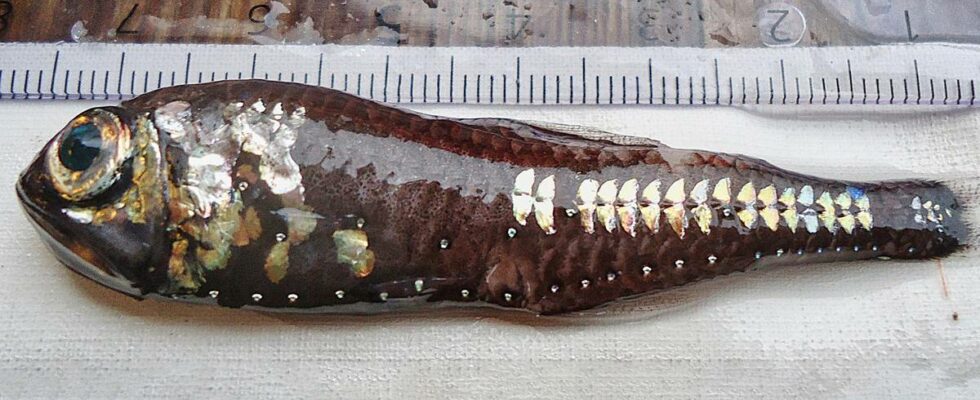Deep down in the sea, the unknown fishes of light spot fish and salmon herring swim. Now researchers have examined the two finger-sized fish species and made interesting discoveries. It turns out that the small, unknown fish can not only be a potential great resource as human food, but also as a source of new medicines and health-giving ingredients. – They have clear anti-inflammatory properties, says senior researcher and nutritional biologist, Sissel Albrektsen. Therefore, they can potentially be used to create new medicines for pain and chronic inflammatory conditions. – It is a very nutritious fish. There is a lot of protein and fat that we need both for human food and animal feed. Most of it is minerals, vitamins and things like Omega 3 fatty acids and things that we all need together. Here, the liquid from the fish is squeezed out into different containers. Photo: Sissel Albrektsen – Can affect blood pressure and blood sugar The findings are the result of a research collaboration between Nofima and other European research institutions in Ireland and Spain. The study was recently published in the renowned scientific journal Marine Drugs. – These are exciting findings, says Albrektsen, who is co-author of the study. The researchers have identified special parts of the protein in the fish. In addition to reducing inflammation, the substance also has the potential to affect blood pressure and blood sugar in a positive way. – Basically, it is assumed that there are huge resources of mesopelagic fish, of which a minimal amount is allowed to be caught today, in ongoing experimental fishing. Some boats have received one-year licenses for this type of experimental fishing, but a little more reliable figures are needed. She adds that this is part of the Meeso project, which must be mapped by Havforskinga. – When you have the whole fish intact, it consists of a lot of protein and fat components. Photo: Bjørn Erik Larsen / Nofima Looks fancy and tastes umami The light spotfish itself is typically only 7–8 centimeters long. He lives deep in the water during the day and migrates up to shallower marshes to feed on crustaceans. – It is a very small, silvery fish. What is characteristic of him is that he has light organs on his head and belly, so he looks almost self-luminous. He looks fancy, says Albrektsen. The findings also show that some of the peptides taste umami, the fifth basic taste after sour, sweet, salty and bitter. He is described as “meaty” and “tasty”. The researchers therefore believe that the fish can also be interesting for the food industry. Furthermore, the findings show that mesopelagic fish can be good for salmon feed. – Salmon silta grew very well and had a good appetite for all feeds. It was a very good attempt where we had to stop the experiment a week earlier than planned, because the fish grew so fast. The experiment thus showed that salmon herring also gives good growth when fat and protein are used as ingredients in feed for salmon. Neither salmon herring nor light spot fish get particularly large, here you see finger-sized salmon herring. Photo: Åsmund Bjordal / Havforskingsinstituttet An underutilized resource Deep-water fish are often referred to as mesopelagic species. They live at sea depths between 200 and 1,000 metres, and in total there are around 250 different species. The researchers assume that there are between 600 and several thousand million tonnes, which makes it an underutilized resource. – As of today, there is no commercial fishing for mesopelagic fish because there are challenges in identifying and finding this fish and catching it, says Albrektsen. Marine research: – Enormous numbers But it is possible to carry out experimental fishing. A number of boats and companies are licensed to fish on smaller volumes of these stocks. Although the Institute of Marine Research does not currently have concrete plans to carry out a larger survey and quantity calculation of these species in the Norwegian economic zone, they know a lot. Webjørn Melle at the Institute of Marine Research. Photo: Havforskingsinstituttet – This has not been seen in a system, but on the basis of sailing in Norwegian waters over many years, we know that there are large occurrences in our waters, which are also global. For all the world’s oceans, it is estimated that there are between 1 and 10 billion tonnes of mesopelagic fish. So the total amount is enormous, explains Webjørn Melle at the Institute of Marine Research. Melle explains that a small trip was made in the North Sea in 2020, in the western parts of the Norskerenna, where 15,000 tonnes of salmon herring were measured. The light spot fish is most relevant in the Norwegian Sea, in Norwegian waters. There are large quantities. – All life in the sea is part of a food chain. Will commercial fishing affect other species that feed on them? – All types of fishing have consequences. These fish are on the menu for both salmon, mackerel and some seabirds, says Melle. At the same time, these are fish that are far down the food chain and the production is large, he adds. Nevertheless, there may be a long way to go before these species are fished commercially. – Commercial fishing will require large resources in the form of large trawlers and a lot of fuel. It is not certain that such fishing can be carried out in a traditional way, says Webjørn Melle at the Institute of Marine Research. Published 09.10.2024, at 12.35 p.m
ttn-69
This tiny fish will help against pain and inflammation – news Nordland

